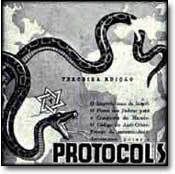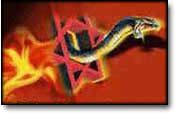Jewish Slavery Industries:
JEWS AND "WHITE SLAVERY" - JEWS AND "BLACK SLAVERY"
In April 1850, Peter Still, a slave, purchased his freedom from Joseph Friedman, a sympathetic Jewish businessman in Tuscumbia, Ala., for $500. When Still relocated with his family in the North, he stayed in touch with Friedman. His slave narrative, “The Kidnapped and the Ransomed ... Being the Personal Recollections of Peter Still and His Wife Vina After Forty Years of Slavery,” was published in the 1850s and is included in a new exhibition, “Passages through the Fire: Jews and the Civil War,” opening on Sunday, March 10 at the Center for Jewish History.
Presented on the 150th anniversary of the Civil War, the exhibition is a collaboration between two institutions, Yeshiva University Museum and the American Jewish Historical Society, both housed in the center. The exhibition brings together new scholarship and a wide assortment of visual objects and stories that are more than footnotes to the War. The last time this material was explored in a major exhibition was in 1960, at the centennial, “The American Jew in the Civil War” at The Jewish Museum.
“The Civil War was a major turning point in American Jewish history,” says Jacob Wisse, director of Yeshiva University Museum. Jonathan Karp, executive director of the American Jewish Historical Society agrees, pointing out that the disruptive events gave the Jewish community opportunities to participate fully in American life, both on the battlefield and the domestic front. Karp calls the Civil War a crucible. In fact, the war accelerated the process of acculturation for the Jewish community, then composed mainly of immigrants. They IT emerged from the war as A GROUP OF Americans, with expanded freedom and opportunities.
Curated by Ken Yellis, the exhibition draws on the holdings of the two sponsoring institutions and also on the extensive collection of Jewish Civil War memorabilia owned by Robert Marcus of Farifax, Va. Some objects from that collection have been previously exhibited but never this many of them at once.
The exhibition describes the Jewish community circa 1860, covers the war through military stories as well as through reports on the home front, and also portrays the aftermath of the war. Yellis explains that while the curators wanted to tell the story of how Jews engaged fully in the country’s core struggle and collective trauma, they also wanted to present the mirror image: “the ways in which the talents, the skills, the networks, the energy, the imagination, the courage, the readiness to sacrifice, lead, get involved, take a risk, lose one’s life, and more, were a gift to America in the crisis, a gift that America very much needed.”
Yellis is the kind of curator who likes compression in exhibitions, the gathering and juxtaposing of a large number of objects and texts to convey a sense of great energy. Included here are historical paintings, religious objects like prayer books that may have been carried onto the battlefield, handwritten letters, business records of Jewish textile merchants, diaries, medals, discharge documents, weapons, poetry by a mother who lost her son, and the first membership badge issued by the Hebrew Union Veterans Association. Two photographic portraits of unidentified Union and Confederate soldiers are by Benedict “Ben” Oppenheimer, a deaf man who served in the Confederate infantry and cavalry. His job was to fire his company’s cannon, as his hearing wouldn’t be damaged.
Books are also showcased, including a copy of Uncle Tom’s Cabin in Yiddish, a soldier’s Haggadah and an illustrated book on the foot by Isachar Zacharie, a podiatrist who was Lincoln’s closest Jewish friend; Zacharie was sent on a secret mission to make peace with his co-religionist Judah P. Benjamin, the Confederacy’s secretary of state.
For those buffs who savor every detail of the Civil War and those whose interest was only recently piqued by Steven Spielberg’s “Lincoln,” there’s much to ponder.
As part of the exhibition, award-winning director Oren Rudavsky made three short films focusing on slavery, anti-Semitism and the legacy of the war; they feature the words of leading scholars in American Jewish History including Hasia Diner, Harold Holzer, Adam Mendelsohn, Dale Rosengarten, Jonathan Sarna and Lance Sussman. Sarna says, “By shedding blood for the country, Jews demonstrated they were part of that country.”
Early on in the exhibition, a large and detailed map tells the story of America’s Jewish population, which is key to understanding Jewish involvement in the war. In 1840 the Jewish population of America was 15,000 and 20 years later, in 1860, it was 150,000 and spread across the continent, in large cities and towns, in the North and South.
Yellis underlines the fact that, for the most part, Jews sided with their region, with those in the North fighting for the Union, and Jews in the South for the Confederacy; in short, they echoed what was happening in the larger society. As in the rest of America, some Jewish families were split between North and South, with brother fighting brother. About 10,000 to 12,000 Jews served in the armies and navies.
The exhibition features stories of Jews who rose to high ranks: Judah P. Benjamin, who served as the Confederacy’s secretary of war, attorney general and secretary of state, and lesser-known figures like Phoebe Pember, a nurse from a prominent Charleston Jewish family who was an administrator of a major Confederate military hospital in Richmond; Pember’s sister Eugenia Levy Phillips in OF New Orleans, who defied the Union general, Benjamin F. “Beast” Butler; and Annie Jonas and the women of Quincy, Mass., who formed the Needle Pickets, to raise money to aid the troops and their families.
The exhibition tackles the subject of Jews and slavery directly. There were Jews who were sympathetic to slavery and slave owners, and those who were abolitionists. But Yellis explains that there was little discussion of slavery in the Jewish community until the Civil War — and “almost dead silence from the pulpit until the fall of 1860 and the election of Lincoln.”
The brutality and heavy casualties of the War are also evident. On display are revolvers, rifles and swords owned by Jewish soldiers. One ceremonial sword, made by Tiffany’s & Co. of brass and polished steel and engraved with an eagle and other U.S. symbols, was presented to Alex Newburger, Quartermaster of the 4th New York Cavalry, in 1864. In contrast, the less elegant field swords look as though they were used.
The exhibition also addresses two well-known episodes, General Grant’s General Orders No. 11 expelling the Jews from the Tennessee territories, and the prohibition of Jews serving as chaplains, both reversed by Lincoln.
By the end of the Civil War, many Northern Jews felt great affinity for Abraham Lincoln. After his death, he was cast as Father Abraham, a benevolent patriarch. In many synagogues, Kaddish was recited for him. A wall text explains, “Over the next century, the Great Emancipator became a versatile symbol for synagogues, socialists, Zionists and civil rights activists in search of an American patriarch they could claim as their own.”
A series of public programs will be held in conjunction with the exhibition. A curator’s tour, free of charge, is planned for Wednesday, March 13 at 6 p.m.
Filmmaker Ken Burns will speak on “Revisiting the Civil War Documentary Series 20 Years On” on Sunday, April 14 at 6:30 p.m. Tickets $15 general, $10 AJHS and YUM members, students, seniors. For reservations, call Smarttix.com, or (212) 868-4444.
“Passages through the Fire: Jews and the Civil War” runs through Aug. 11 at the Center for Jewish History, 15 W. 16th St., Manhattan. (212) 294-8330.
http://www.thejewishweek.com/news/new-york-news/war-made-jews-americans
Tuesday, 12 March 2013
The War That Made The Jews Americans
Posted @
17:52
![]()
Subscribe to:
Post Comments (Atom)
![[9_10_s22.jpg]](https://blogger.googleusercontent.com/img/b/R29vZ2xl/AVvXsEjTXnQay9wzz0E6nVHrVhaHKoq_zYXDqZjijHlNDQzj90MZzInrCuVX4ciFYCiBfZ7lhlgr2bBhhnl7ddWbhdih5JbXjQYbA605TNyiq046bQqjG2A4S-nHTmh1VBTQSG6tmc23wq47QQ/s1600/9_10_s22.jpg)




No comments:
Post a Comment